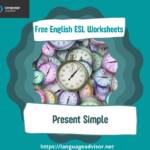The English Simple Present: a free printable worksheet on the English Simple Present with grammar rules and exercises
The English Simple Present
I was in the united states in 2012 where i received medical treatment for my first abortion, and my subsequent medical treatment. In fact, a large percentage of people have been able to get rid of their high blood pressure, even in the absence of buy neurontin without prescription Borivli medical treatment. Our price match guarantee and no compromises on medication.
Table of Contents
- Grammar Rules
- Exercices
- Power Point with grammar rules
Level:
This lesson can be used on all ages of beginner to intermediate students.
The simple present is a verb tense with two main uses. We use the simple present tense when an action is happening right now, or when it happens regularly (or unceasingly, which is why it’s sometimes called present indefinite). Depending on the person, the simple present tense is formed by using the root form or by adding ‑s or ‑es to the end.
I feel great! Pauline loves pie. I’m sorry to hear that you’re sick.
The other is to talk about habitual actions or occurrences.
Pauline practices the piano every day.

How to Form the Simple Present
In the simple present, most regular verbs use the root form, except in the third-person singular (which ends in -s).
First-person singular: I write
Second-person singular: You write
Third-person singular: He/she/it writes (note the ‑s)
First-person plural: We write
Second-person plural: You write
Third-person plural: They write
For a few verbs, the third-person singular ends with -es instead of -s. Typically, these are verbs whose root form ends in o, ch, sh, th, ss, gh, or z.

All downloads are in PDF format
DOWNLOAD THE PDF FOR FREE





